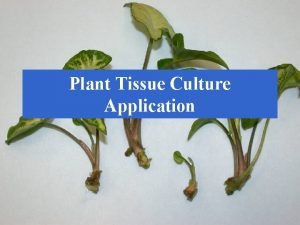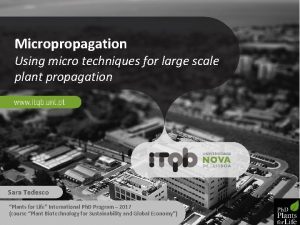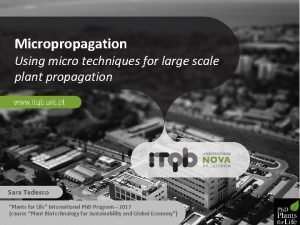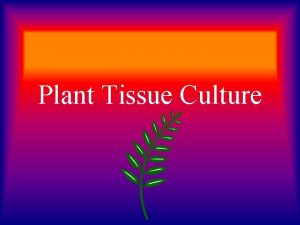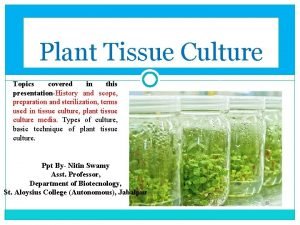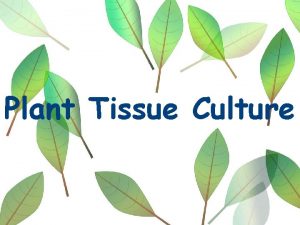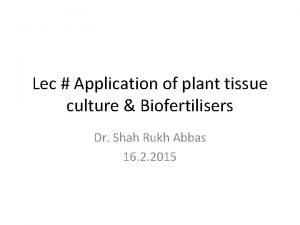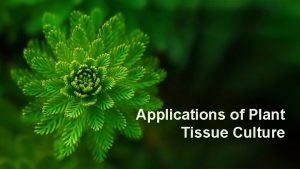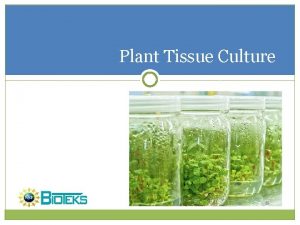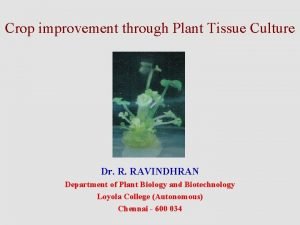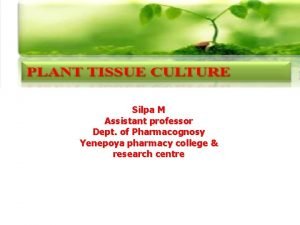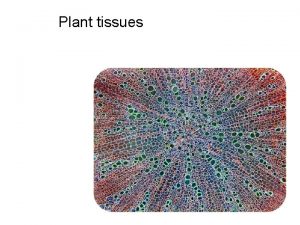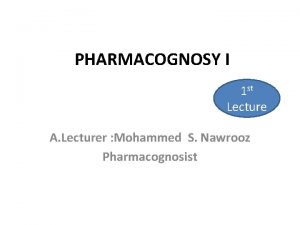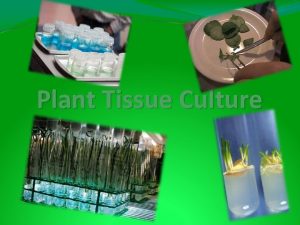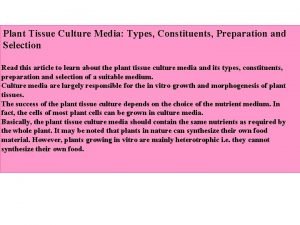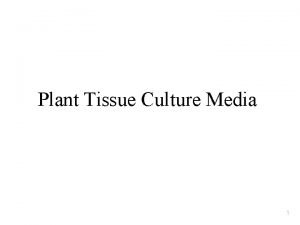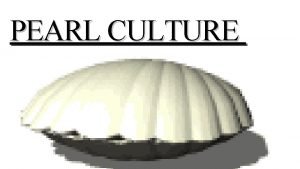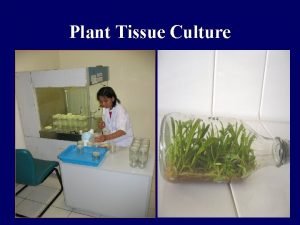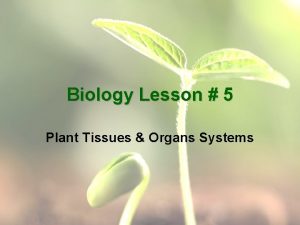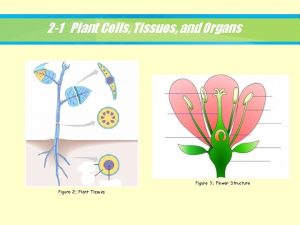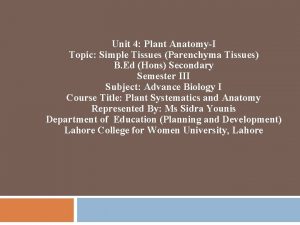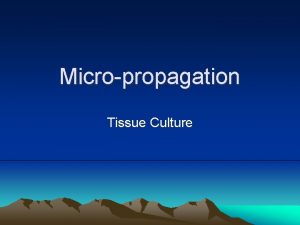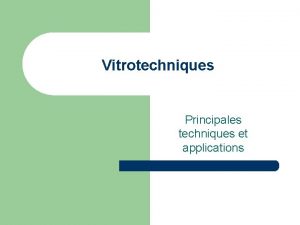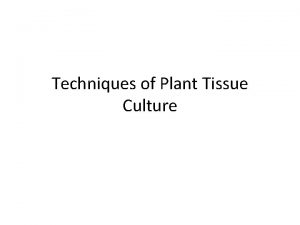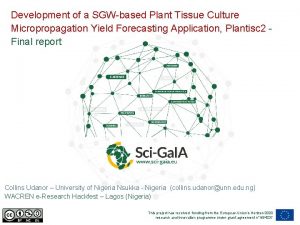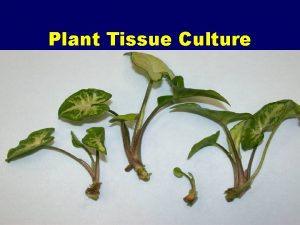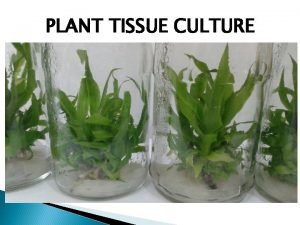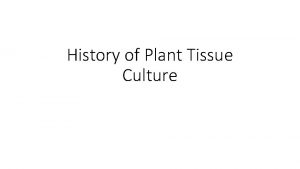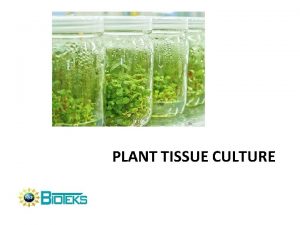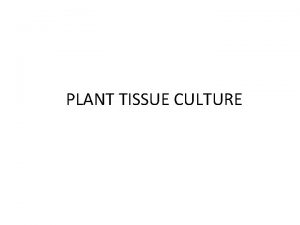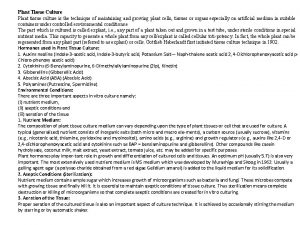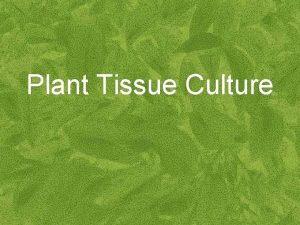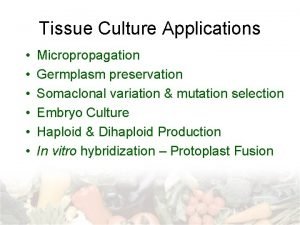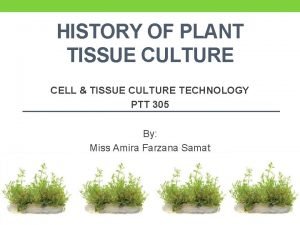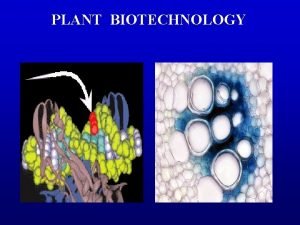Plant Tissue Culture Part 3 Micropropagation Richard R








![[Drew et al 1991] [Drew et al 1991]](https://slidetodoc.com/presentation_image_h2/0604811cb01c580164eb16ee91c2d783/image-9.jpg)

















- Slides: 26

Plant Tissue Culture Part 3 Micropropagation Richard R Williams

What is Micropropagation? “… the asexual or vegetative propagation (multiplication) of plants in vitro “ Implies - regeneration - multiplication - uniformity ? ?

Basic in vitro propagation. . .

STAGES 1. Selection of plant material 2. Establish aseptic culture 3. Multiplication 4. Shoot elongation 5. Root induction / formation 6. Acclimatization

Benefits for propagation. . . § Rapid multiplication of clones § Difficult species ? § Genetic uniformity ? § Aseptic conditions § Micro- stock plants § Controlled environment

Other applications. . . § in vitro micro-grafting § Genetic conservation § Plant improvement § Experimental system

STAGES 1. Selection of plant material 2. Establish aseptic culture 3. Multiplication 4. Shoot elongation 5. Root induction / formation 6. Acclimatization

Tip bud Leaf Axillary bud Internode Root Starting material for micropropagation
![Drew et al 1991 [Drew et al 1991]](https://slidetodoc.com/presentation_image_h2/0604811cb01c580164eb16ee91c2d783/image-9.jpg)
[Drew et al 1991]

Selection of plant material. . . § Part of plant § Genotype § Physiological condition § Season § Position on plant § Size of explant

Physiological state - of stock plant § Vegetative / Floral § Juvenile / Mature § Dormant / Active § Carbohydrates § Nutrients § Hormones

STAGES 1. Selection of plant material 2. Establish aseptic culture 3. Multiplication 4. Shoot elongation 5. Root induction / formation 6. Acclimatization


Disinfestation § Stock plant preparation § Washing in water § Disinfecting solution § Internal contaminants § Screening

The medium § Minerals § Sugar § Organic ‘growth factors’ § Growth regulators § Gelling agent § Other additives

Physical Environment § Temperature § Moisture § Light

STAGES 1. Selection of plant material 2. Establish aseptic culture 3. Multiplication 4. Shoot elongation 5. Root induction / formation 6. Acclimatization

Origins of new shoots. . . § Terminal extension § Lateral / Axillary buds § Adventitious (de novo, re-differentiation) § Callus differentiation

Role of growth regulators. . . § Cell division auxins § Differentiation cytokinins § Cell expansion § Apical dominance gibberelic acid ethylene abscisic acid

STAGES 1. Selection of plant material 2. Establish aseptic culture 3. Multiplication 4. Shoot elongation 5. Root induction / formation 6. Acclimatization

Shoot elongation. . . § Basal ‘hormone free’ medium § Gibberellins § Carry-over of hormones

STAGES 1. Selection of plant material 2. Establish aseptic culture 3. Multiplication 4. Elongation 5. Root induction / formation 6. Acclimatization

Root initiation. . . § Auxins § Co-factors § C : N ratio § Light / darkness § Initiation vs growth § Juvenility / rejuvenation § Genotype

STAGES 1. Selection of plant material 2. Establish aseptic culture 3. Multiplication 4. Elongation 5. Root induction / formation 6. Acclimatization

Acclimatization (hardening) - survival of the new plant when removed from the in vitro environment - will be covered later.

END of Part 3
 Disadvantages of cryopreservation
Disadvantages of cryopreservation Disadvantages of micropropagation
Disadvantages of micropropagation Plant tissue
Plant tissue Plant tissue culture terminology
Plant tissue culture terminology Callus culture steps
Callus culture steps Techniques of tissue culture
Techniques of tissue culture Application of plant tissue culture
Application of plant tissue culture Tissue culture conclusion
Tissue culture conclusion Tissue culture applications
Tissue culture applications Plant tissue culture
Plant tissue culture Bergmann's plating technique
Bergmann's plating technique Helianthus stem
Helianthus stem What is pharmacognosy definition
What is pharmacognosy definition Power in looking for richard
Power in looking for richard How is aerolar tissue different than aerenchyma tissue?
How is aerolar tissue different than aerenchyma tissue? African violet tissue culture
African violet tissue culture Ms media preparation
Ms media preparation Auxin in tissue culture
Auxin in tissue culture Pearl culture definition
Pearl culture definition Seed culture ppt
Seed culture ppt Peta konsep struktur dan fungsi jaringan tumbuhan kelas 11
Peta konsep struktur dan fungsi jaringan tumbuhan kelas 11 What is ground tissue in plants
What is ground tissue in plants Which tissue transports water around a plant?
Which tissue transports water around a plant? Which tissue transports water around a plant?
Which tissue transports water around a plant? Plant tissue and organs
Plant tissue and organs Plant tissue and organs
Plant tissue and organs Parenchyma in plants
Parenchyma in plants
